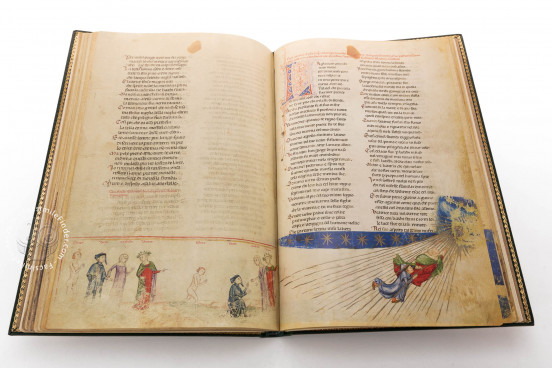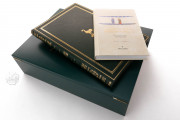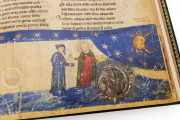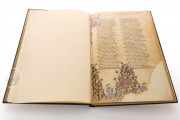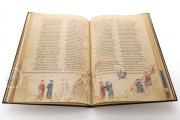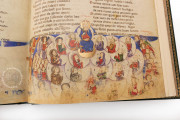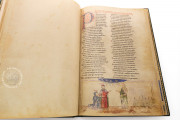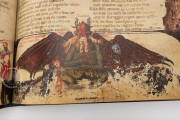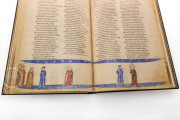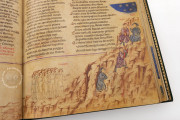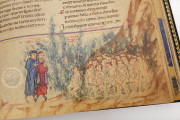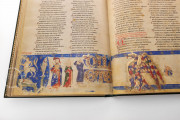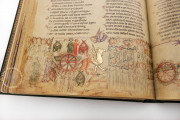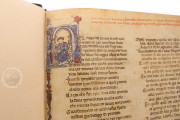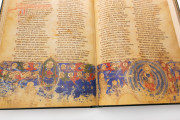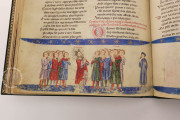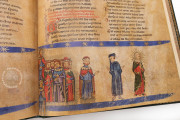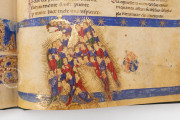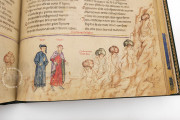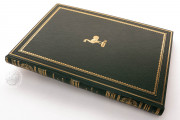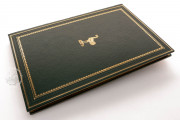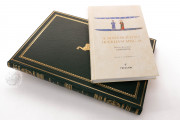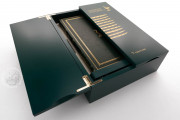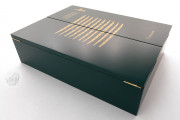The Holkham Manuscript of the Divine Comedy by Dante Alighieri, a long Christian moralizing poem, was created in Italy in the third quarter of the fourteenth century. It boasts 146 partially framed miniatures occupying its pages' lower margins. They trace the poet's voyage, which he places in the year 1300, through the underworld accompanied by the ancient Roman poet Virgil, and then Beatrice—Dante's contemporary, although whether historical or fictional is debated—and finally the twelfth-century Saint Bernard of Clairvaux.
Dante's Commedia, regarded as a masterpiece of early Italian literature, recounts a journey through nine circles of hell (in Inferno); seven terraces where souls purge themselves (in Purgatorio); and then through nine heavenly spheres and, finally, into the Empyrean (in Paradiso).
Two Male Poets, a Woman, and a Theologian
The manuscript's miniatures are probably the work of three artists, each responsible for one of the poem's canticles (Inferno, Purgatorio, and Paradiso). Through most of the first two canticles, Dante—in the Holkham Manuscript, always youthful, dressed in blue, and wearing a beret that flops to the side of his head—is led by Virgil—always pictured with a long beard and dressed in a red tunic and hat (pp. 1-105).
Since the pagan Virgil cannot enter paradise, Beatrice—who personifies Christian divine love—takes over his role as Dante's spiritual and physical guide as the poet nears that realm. She is presented in the manuscript as an aristocratic woman in a red tunic and a thick cloak of a contrasting color, with her hair covered (pp. 106-144). Rays often emanate from her head. Saint Bernard of Clairvaux leads Dante at the poem's end (pp. 146-147).
Figures of Ancient Myth and Contemporary History
The artists of Inferno and Purgatorio render in detail the many characters—whether mythological or historical—Dante and Virgil encounter. For example, the minotaur (half human/half bull), the centaurs (half human/half goats), and the harpies (half human/half bird) of Inferno, cantos 12-13, are imbued with personality (pp. 17-19).
Similarly, the artist captures the affection Dante felt for his guardian Brunetto Latini by showing the poet gently touching the head of Latini's soul—pictured as a small naked figure—while Virgil turns his attention to a group of sodomites in a rain of fire (p. 22).
Extended Compositions
Some of the compositions extend beyond the lower margin of the page, often to dramatic effect. Dante describes purgatory as a mountain to be climbed, and the illuminator often depicts Virgil and Dante, sometimes twice in the same image, climbing a rocky slope that extends up into the outer margin of the page (e.g., on p. 63).
Protagonists and Situations Clarified
Most of the people in the miniatures are identified by inscriptions written in red in an informal spiky script. Situations, too, are described, and sometimes direct speech is attributed to those depicted. For example, the man in the tree of the gluttonous illustrating Purgatorio, canto 24, urges Virgil and his companions forward: "Pass farther on!" (p. 105)
Rounded Script
In the Holkham Manuscript, the text of Dante's poem was written by two scribes, one responsible for Inferno and the other for Purgatorio and Paradiso. Both wrote the poetic text in two columns in a rounded Gothic script characteristic of Italian writing of the period.
Inferno opens with a historiated initial N with a portrait of Dante (p. 1). The other canticles open with handsome puzzle initials, letters rendered in red and blue in shapes that interlock like jigsaw puzzle pieces, with flourishes in purple and red (pp. 45 and 113).
Named for Its Former Home
The manuscript owes its nickname to its former home at Holkham Hall in Norfolk when it was in the possession of Thomas William Coke (1752-1842), Earl of Leicester. The Bodleian Library acquired it in 1981. The manuscript is preserved in its Holkham binding of green leather over pasteboard, which was conserved in 2021.
We have 1 facsimile edition of the manuscript "Divine Comedy - Holkham Manuscript": Manoscritto Holkham Misc. 48 facsimile edition, published by Istituto dell'Enciclopedia Italiana - Treccani, 2021
Request Info / Price
